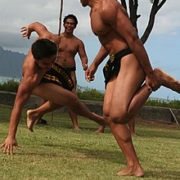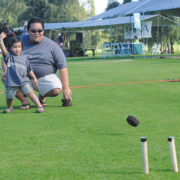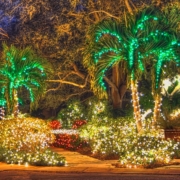From Makahiki to Mele Kalikimaka: How Christmas Came to Hawai’i
If you’ve ever celebrated Christmas on the islands, you know it’s a totally different affair. Kanakaloka, affectionately called Shaka Claus, arrives on an outrigger canoe instead of a sleigh, palm trees get decorated in lieu of traditional evergreens, and Christmas is often a day for family cookouts on the beach. Before the Christian holiday and its traditions arrived with the Protestant missionaries in the 1800’s, though, Native Hawaiians had celebrated with a four-month long New Year Festival called Makahiki. Read on to learn more about Makahiki, the ancient precursor to Christmas and New Years on the islands!
Makahiki: A Time of Peace and Celebration
Much like the holiday season on the mainland (Thanksgiving, Christmas, New Years), the festival of Makahiki was a time of celebration, community, and fresh starts for the new year. Makahiki means “year” or “new year” in Hawaiian, and the festival honored the god of fertility, peace, and agriculture, Lono-i-ka-makahiki. During this period, stretching from October/November – February/March, war with neighbors was forbidden, or kapu, as was daily labor, and people could look forward to feasts, sporting events, and hula in their communities.

A Hawaiian one-legged wrestling match at a Makahiki celebration
The start of the festival season was dependent on when the star cluster Makali’i (the Pleiades in Western astronomy), was visible from the Western side of each island after sunset. The next new moon after the sighting of Makali’i would begin the Makahiki season, with traveling celebrations occurring clockwise around the islands. A figure of the god Lono, accompanied by Akua Pa’ani, the god of sports, was carried across the island, with his arrival in an ahupua’a (a traditional Hawaiian land division) marking the start of the actual festival.
Before Lono’s arrival, ho’okupu (offerings) were made to both local ali’i (royalty), and Lono himself. Once Lono made his way into the

A game of ‘ulu maika (Hawaiian “bowling”) at Oahu’s Makahiki celebration
ahupua’a, though, it was a time of hula dancing, feasting, music, and sporting events for the people. Wrestling, boxing, Hawaiian “bowling”, and canoe races were all common events, as well as lava sled racing on some of the islands. Priests, or kahuna, held important religious ceremonies to ensure a plentiful growing season, and a large ho’okupu was set adrift at sea as the final offering to Lono.
On the final days of the festival, the high chief would take a canoe out to sea, and upon his return he would have to ward off spears being thrown at him, reenacting the legend of Lono. The high chief would then make the final offerings to Lono, and the festival would end with a village-wide feast at dawn. While the high chief and high priest would continue religious ceremonies for several more days, for the average people the festival was over, and the carriers would take Lono to the next ahupua’a to continue the festivities. This circuit of festivals would last about four months before Lono finally returned to the West side of the island.
Makahiki Becomes Mele Kalikimaka: Missionaries Arrive in Hawai’i
In the 1820’s, the first Protestant missionaries began to arrive in Hawai’i from the United States, which would change the structure of Hawaiian society and the holidays that were deemed important. The missionaries were incredibly successful at imposing Christian values and holy days upon the Native Hawaiians, which meant Makahiki fell to the wayside, and Christmas took over. The first recorded instance of a Christmas celebration in Hawai’i occurred on Kauai in 1786 with the arrival of English sea captain George Dixon, however it did not become a holiday in the Kingdom of Hawai’i until King Kamehameha IV proclaimed it in 1862. This is not to say Makahiki disappeared completely, though, as it became popular once again during the second Hawaiian Renaissance in the 1970’s!
Shaka Claus and Christmas Palm Trees: Modern Christmas in Hawai’i

Fabulously festive Christmas palm trees
Like any part of the Western world, Christmas has become firmly rooted as an important winter holiday, even if it looks a little different on the islands! Instead of Santa Claus donning a red suit and gliding across rooftops in a sleigh, Kanakaloka arrives in an outrigger canoe and wears slippers and a Hawaiian shirt. Decorated evergreen trees are replaced by towering palm trees covered in lights, and a cozy Christmas by the fire is swapped for a beachside barbecue. The essence of the holiday remains much the same as when the Hawaiians celebrated Makahiki, though: good food, good company, and eagerly anticipated celebrations to end the old year and ring in the new!
Whether you’ve already celebrated Makahiki, or you’re looking forward to Christmas and any other winter holidays, the Kauai Kahuna team is wishing you all a very merry holiday season, and best wishes for the new year. Aloha and Mele Kalikimaka!
